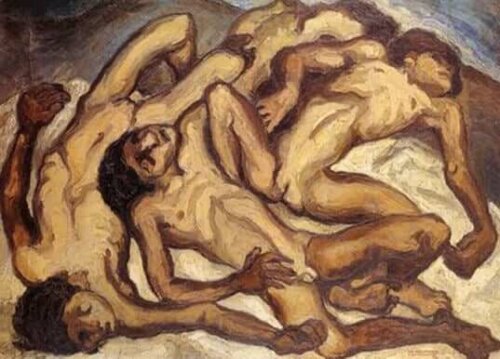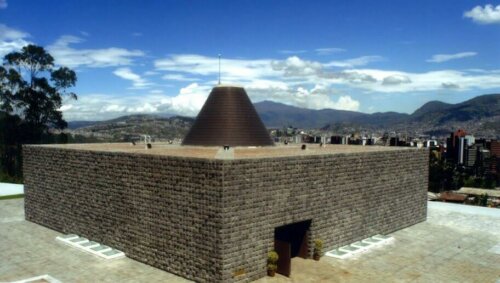The Mestizo Art of Oswaldo Guayasamín

Oswaldo Guayasamín was an indigenous painter who became very popular in Latin America and the world. He left his mark on the entire art world. In addition to his significant artistic legacy, he also left behind a truly astounding work – La Capilla del Hombre. This is a building that houses some of his work.
Guayasamín’s work is filled with great vitality and strength. He gave color to the silence, bitterness, and injustice he observed in his native country of Ecuador. He included marginalization and social issues in his pieces.
This artist’s last name actually means “house of wisdom” in Quechua, the language of the Incas. Through his portrayals of the world around him, his work became vitally important in representing issues in Latin America.
About Oswaldo Guayasamín

Guayasamín was born in Quito, Ecuador on July 6, 1919. He was born into a humble family and was the eldest of 10 brothers. Guayasamín’s father, José Miguel, was of indigenous descent. José worked as a tractor driver.
Guayasamín’s mother was named Dolores Calero. She was of mixed descent and was truly dedicated to her children and home. Unfortunately, Dolores died at 46. Her death devastated the family. It also left a significant mark on little Oswaldo, who would grow up in poverty and deprivation.
Guayasamín began to show his artistic vocation at the young age of seven. This is when he began to paint. In fact, his first paints were actually just milk with watercolors.
However, Oswaldo Guayasamín was not successful academically. In fact, six different schools expelled him due to what his teachers referred to as “lack of talent.” Afterward, his father forced him to study a technical profession like his brothers.
In 1933, against his father’s advice, Guayasamín enrolled in the School of Fine Arts. However, this was a school that held tightly to traditional ideas of art.
During his time at the school, Guayasamín’s talent and work began to take shape. In Ecuador, these years are marked by violence and injustice. You can see these themes reflected in the young Guayasamín’s work. For example, you can see his anger and rage in his painting “The Dead Children.”
The painting shows a brutal scene of corpses piled up on a street in Quito. Guayasamín also included his best friend in the painting, who was killed by a stray bullet.
Oswaldo Guayasamín’s paintings as social commentary

From then on, Guayasamín took a clear position against the cruelty and injustice of his society. His work demonstrated his hatred of discrimination against the poor, indigenous people, blacks, and the defenseless.
Guayasamín’s indigenous ancestry, his impoverished childhood, the murder of his young friend, and the wars occurring in the world shaped his work. He demonstrates this ideological attitude through his paintings, as well as his political preferences.
In 1940, at the age of 21, Guayasamín graduated from the School of Fine Arts as a painter and sculptor. Then, the following year, he won his first two awards.
Nelson Rockefeller attended Guayasamín’s first exhibition. The work was so impressive to Rockefeller that he bought 5 paintings. He also extended an invitation to Guayasamín to visit the United and show his work there for 7 months.
Guayasamín took advantage of this offer. He used the time to visit all the museums in the country. In fact, he viewed the work of world-class artists, such as El Greco, Goya, Velázquez, Picasso, Orozco, and others.
My paintings aren’t easy. They’re not posters. But I put my entire soul into them and they reflect eternal themes, such as hatred, love, tenderness.
-Oswaldo Guayasamín-
His series of paintings
Huacayñan

1945 was a very important year for Oswaldo Guayasamín as he began a journey from Mexico to Patagonia. During this trip, he traveled to many towns and cities, taking notes and drawing pictures.
As a result of this pilgrimage to the soul of Latin America, Guayasamín created his first series of paintings. He called the series, which consists of 103 works, “Huacayñan.” In Quechua, this means “Trail of Tears.”
This series is characterized by its vision of the mestizo and black indigenous people. He represents their cultures, as well as expressions of joy and sadness. Guayasamín highlighted tradition, identity, and religion as elements in the series. He also demonstrates a clear preference for the Andean countries.
The Age of Anger
Oswaldo Guayasamín’s second series is “The Age of Anger.” He began this series in 1961. His goal was to show places and events that led to murders of groups of people during the 20th century through a series of images. However, according to Guayasamín, this series will never truly be finished. He viewed the series as part of a historical process that is still ongoing.
Then, in 1976, he created the Guayasamín Foundation. He managed the foundation together with his children until his death. Through the foundation, Guayasamín donated all his artistic heritage to the people of Ecuador. He also was able to create three museums: Pre-Colombian Art, Colonial Art, and Contemporary Art.
Today, you can still admire paintings from his series “The Age of Anger” in the Museum of Contemporary Art. Both this series and Huacayñan became the property of the Ecuadorian government to prevent anyone from dividing them up.
In the 80s, Oswaldo Guayasamín started a new series called “As long as I live, I”ll always remember you.” People also refer to this series as “The Age of Tenderness” or simply “Tenderness.”
Guayasamín dedicated this series to his mother, as a way of thanking her for her unconditional support in his artistic career. In Guayasamín’s words, this series is also a “tribute to mother Earth, the defense of life, [and] the defense of human rights.”
La Capilla del Hombre, the legacy of Oswaldo Guayasamín

Oswaldo Guayasamín wanted to leave a great legacy to humanity. So in 1996, he began his most important work in Quito. He created a stone building called “La Capilla del Hombre.”
This work, according to Guayasamín, is a tribute to all humans. However, it is especially for Latin American people and their suffering, struggles, and achievements. The building is supposed to represent the pre-Columbian world, as well as the struggles of conquered and colonized Latin American and miscegenation.
Oswaldo Guayasamín died on March 10, 1999, leaving his greater work, “La Capilla del Hombre,” unfinished. The chapel was ultimately completed in 2002.
Prior to his death, Guayasamín created an award for UNESCO for artistic merit. This award receives contributions from entities from Ecuador, Chile, Bolivia, and Venezuela. The Guayasamín Foundation remains in solidarity with the artists, singers, and painters of Latin America.
Guayasamín’s ashes rest inside a clay pot under the “Tree of Life.” Guayasamín himself planted this pine tree. It’s located outside the house where he spent his last 20 years.








